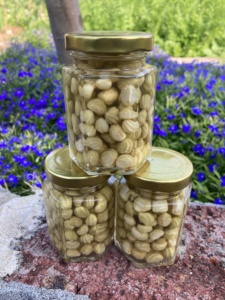Nasturtiums are a true gem in the world of gardening, celebrated for their vibrant flowers, easy cultivation, and a wide range of culinary applications. These beautiful and versatile plants grow really well through a Perth winter and once you plant them they will pop up year after year with no effort. In this article, we’ll explore the many uses of nasturtiums, from their stunning appearance to their culinary potential and medicinal properties.
Nasturtiums: A Garden Delight
Nasturtiums (Tropaeolum majus) are known for their stunning and vibrant blooms, which come in various colours, including shades of orange, red, and yellow. Their round, flat leaves and distinct trumpet-shaped flowers make them a popular choice for adding colour and interest to gardens and landscapes. Nasturtiums are easy to grow, making them an excellent option for both novice and experienced gardeners.
1. Garden Ornament
Nasturtiums are ideal for adding a pop of colour to your garden. And will thrive with minimal maintenance. The vibrant flowers and lily pad-like leaves will not only enhance the visual appeal of your garden but also attract pollinators like bees and butterflies.
2. Companion Plant
Nasturtiums are excellent companion plants for your vegetables and herbs. They help deter certain garden pests like aphids, whiteflies, and cucumber beetles, making them a natural form of pest control.
3. Nasturtiums in the Kitchen
Beyond their ornamental value, nasturtiums are a treasure trove of culinary possibilities. Every part of this plant, from the leaves to the flowers and seeds, is edible, offering a unique peppery flavour and a burst of colour to your dishes.
Here’s how you can eat each part:
-
Edible Flowers
Nasturtium flowers are the most commonly used part in culinary applications. They have a peppery, slightly spicy taste, similar to rocket. These flowers can be used as a garnish for salads, soups, and other dishes.
-
Flavourful Leaves
Nasturtium leaves are a bit spicier than the flowers and are often used as a substitute for rocket or watercress in salads. You can also blend nasturtium leaves into pesto, mix them into soups, or use them as a wrap for small appetizers or canapés.
-
Pickled Nasturtium Seeds
The unripe seeds of nasturtiums can be pickled and used as a condiment. They have a flavour profile similar to capers, making them an excellent addition to salads, sandwiches, and pizzas.
Here are a couple of recipes we like:
Nasturtium Pod Pickles: Poor Man’s Capers by Cornersmith
Lacto-fermented Nasturtium Capers by Forager Chef
4. Medicinal Uses of Nasturtium
Nasturtiums are not just a culinary delight; they also have a history of medicinal use due to their potential health benefits:
- Antibacterial Properties: Nasturtiums contain compounds that have natural antibacterial properties, which can help combat bacterial infections.
- Immune Support: The high vitamin C content in nasturtiums can help support the immune system.
- Respiratory Health: Nasturtiums have been used to relieve symptoms of respiratory ailments like coughs and colds.
- Antioxidant Benefits: The plant’s antioxidants can help protect cells from oxidative stress.
What an awesome plant! If they’re missing from your garden pick up some seeds and plonk them in at the first sign of spring. They’ll need regular water to start with but are pretty hardy. Baileys have some growing tips in this blog article.


